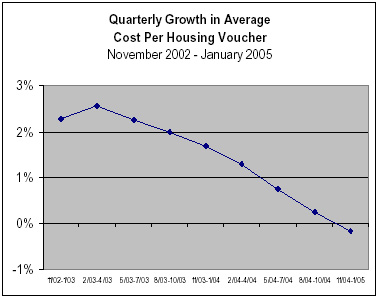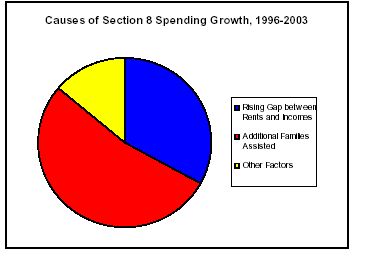GROWTH IN HOUSING VOUCHER COSTS HAS SLOWED SHARPLY
|
PDF of
fact sheet Full Report: HTM | PDF Methodology: PDF |
| If you cannot access the files through the links, right-click on the underlined text, click "Save Link As," download to your directory, and open the document in Adobe Acrobat Reader. |
The Administration has pointed to “spiraling” costs for the nation’s leading low-income housing program to justify radical changes in the program’s funding structure and the elimination of many key protections for low-income families. A Center report based on recent HUD data, however, finds that growth in program costs has leveled off since 2003. This suggests the program’s existing cost-control mechanisms have worked as intended.
The program, called the “Section 8” Housing Choice Voucher program, provides about two million low-income households with vouchers they can use to rent modest housing in the private market. Most recipients of vouchers are low-income senior citizens, people with disabilities, or working families.
- Growth in average voucher costs has dropped below inflation. HUD data show that the average cost of a housing voucher rose by about 2.1 percent from January 2004 to January 2005, well below the overall rate of inflation. Growth in per-voucher costs declined for seven consecutive quarters after peaking in February-April 2003. HUD and Congress have made changes in the program’s funding rules in recent years to ratchet down voucher costs, but this was not the main cause of the recent slowdown in cost growth. Nearly half of the slowdown occurred before HUD first announced those changes in April 2004.

- Overall Section 8 spending has also slowed, and is expected to grow only moderately in the future. Growth in overall spending under Section 8 — which includes both the voucher program and a separate project-based housing assistance program — also fell, from an annual increase of 13.2 percent in fiscal year 2003 to 6.7 percent in fiscal year 2004. The Congressional Budget Office estimated in 2004 that growth in overall Section 8 expenditures would drop in 2005 to just 1.8 percent.[1] This slow growth is expected to continue in 2006 and beyond.
- Earlier cost increases mostly reflected temporary factors that have since eased.
- Growing gap between rents and incomes. A voucher covers the difference between the cost of a modest apartment and about 30 percent of a family’s income, so if rents increase or incomes decline, the average cost of each voucher will go up. During 2001 and 2002, a “perfect storm” — consisting of a hot housing market and a cooling economy — caused the gap between rents and incomes to grow faster than at any time in more than 30 years, significantly raising average per-voucher costs. Rental cost increases slowed beginning in 2003 and average incomes among the poorest fifth of households leveled off after dropping in 2001 and 2002. Because of lags in the process for setting voucher program rents, the full effect of these changes was not felt immediately — but it is being felt now.
- Increases in the number of vouchers. Between 1996 and 2003, Congress added roughly 657,000 new vouchers. More than two-fifths of these vouchers went to families losing other types of federal housing subsidies — such as public housing, assistance under federal mortgage subsidy programs, and project-based Section 8 — as a result of Congressional decisions to allow those subsidies to end. The remaining vouchers were used to reduce the number of families on voucher waiting lists. The demand for vouchers far exceeds the supply: only about one in every four low-income families eligible for vouchers receives any type of federal housing assistance. The number of new vouchers has fallen sharply, however, from a peak of over 130,000 in 2001 to about 30,000 a year (all of which will go to families losing other housing assistance) from 2003 to 2005.
As the pie chart above shows, a little more than half (53 percent) of the spending growth in the Section 8 program from 1996 to 2003 reflected increases in the number of vouchers, while a third (33 percent) reflected the increases in per-voucher costs needed to keep pace with the widening gap between rents and incomes. (Section 8 consists of the voucher program and a separate “project-based” housing assistance program.) These pressures are not expected to return; this is the primary reason why the slowdown in Section 8 cost growth is expected to continue.
- Drastic program changes not needed to control costs. The Administration has proposed fundamentally changing the voucher program’s funding structure and eliminating key protections for low-income families. Those pushing these plans argue that these changes are needed to bring voucher cost growth “under control.” This argument is not correct, as it fails to take into account that the period of rapid voucher cost growth has already ended, and that existing cost containment measures are proving themselves up to the task of managing program expenditures.
End Note:
[1] CBO has not issued an updated version of this estimate since 2004.
